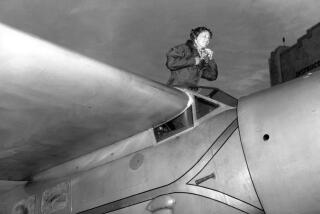Tests Show Relic Could Be From Amelia Earhart’s Plane
NEW KENSINGTON, Pa. — A jagged scrap of aluminum is probably old enough to have come from Amelia Earhart’s last flight, preliminary tests have found, supporting a theory that she landed on an island before vanishing 59 years ago.
But metals experts at the Alcoa Technical Center near Pittsburgh could not determine the relic’s exact age.
“We can’t say it’s Amelia’s, but we can’t say it’s not from that time period,” Victor Zadnik, a chemist at the center, said.
Richard Gillespie, a former charter pilot and aircraft accident investigator, found the tray-sized artifact during a visit in 1991 to the Republic of Kiribati, a central Pacific island nation.
Gillespie believes that Earhart, who was attempting to become the first woman to fly around the world, and her navigator, Fred Noonan, landed the Lockheed Electra on the island of Nikumaroro and died there undiscovered by would-be rescuers.
“At this preliminary point in looking at the results of the tests, I’m optimistic,” Gillespie said.
Earhart’s disappearance on July 2, 1937, has long provoked conspiracy buffs to theorize about her failure to arrive as planned on tiny Howland Island, en route to Hawaii and Oakland, Calif. They contend that she was spying on possible Japanese military activities in the Marshall Islands and fell into Japanese hands. Others say her plane crashed into the ocean and sank.
Gillespie heads the International Group for Historic Aircraft Recovery, a nonprofit foundation based in Wilmington, Del., that he set up 12 years ago to probe aviation mysteries like Earhart’s disappearance.
He argues that Earhart’s radio messages show that she followed a specific compass reading that would have taken her over Nikumaroro, known then as Gardner Island, as she ran low on fuel. Reports that she sent radio messages for three days after failing to reach Howland Island indicate that she and her plane survived any landing, he says.
Scientists at the center, 28 miles northeast of Pittsburgh, sawed samples from the artifact and compared them to parts of four other aluminum airplanes known to have been built from the mid-1930s to 1944. They also bounced X-rays off the metal to learn more about its composition.
Officials pored separately through archives to learn if a barely visible “AD” stenciled on one side of the relic could identify it as an Alcoa product manufactured at the time that Earhart’s plane was built.
“The analysis of historical documents would indicate that there is a likelihood it was made prior to the mid-1940s,” said Milton Milner, the center’s manager of technical standards.
“It doesn’t prove anything, but it also doesn’t undermine or go contrary to Mr. Gillespie’s work,” he said.
More to Read
Sign up for Essential California
The most important California stories and recommendations in your inbox every morning.
You may occasionally receive promotional content from the Los Angeles Times.










